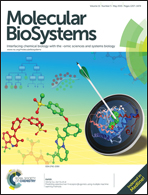Plasma metabolic profiling after cortical spreading depression in a transgenic mouse model of hemiplegic migraine by capillary electrophoresis – mass spectrometry†
Abstract
Migraine is a common brain disorder characterized by recurrent attacks of severe headaches and other neurological symptoms. In one-third of patients headaches are accompanied by auras, which consist of transient visual and sensory disturbances, believed to be caused by cortical spreading depression (CSD). CSD is characterized by a wave of neuronal and glial depolarization with concomitant changes in metabolite concentrations in the brain and cerebrospinal fluid. It remains unknown whether CSD-induced brain metabolic changes can be captured outside the central nervous system, i.e., in peripheral fluids. This study investigated plasma metabolic changes in transgenic mice that harbor a gene mutation in voltage-gated CaV2.1 Ca2+ channels previously identified in patients with familial hemiplegic migraine, a subtype of migraine with auras. The use of a mouse model allows investigation of molecular changes occurring shortly after CSD, which is notoriously difficult in patients. Capillary electrophoresis – mass spectrometry was used for the analysis of plasma samples to obtain, for the first time, a comprehensive view of molecular changes immediately after experimentally induced CSD. Multivariate data analysis showed a clear distinction between profiles of transgenic and wild-type animals after CSD. Two metabolites considered important for this discrimination were tentatively identified as being lysine and its by-product pipecolic acid with additional evidence provided by hydrophilic interaction chromatography combined with tandem mass spectrometry. The changed metabolites suggest a compensatory increase in GABAergic neurotransmission upon enhanced excitatory neurotransmission. These results show that CSD induces metabolic remodeling in transgenic migraine mice that can be captured and measured in plasma.


 Please wait while we load your content...
Please wait while we load your content...